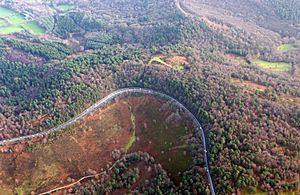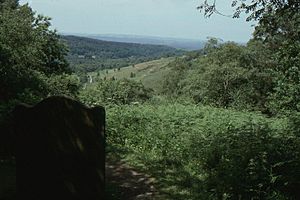Devil's Punch Bowl facts for kids
| Site of Special Scientific Interest | |

The Devil's Punch Bowl seen from below
|
|
| Area of Search | Surrey |
|---|---|
| Interest | Biological |
| Area | 282.2 hectares (697 acres) |
| Notification | 1986 |
| Location map | Magic Map |
The Devil's Punch Bowl is a huge, natural bowl-shaped area in Surrey, England. It's a popular place for visitors and is also a special area for nature, known as a Site of Special Scientific Interest. It covers about 282 hectares (that's like 700 football fields!).
This amazing natural amphitheatre has many old stories linked to it. The main road from London to Portsmouth (the A3) used to go right around the edge of the Punch Bowl. But in 2011, a new tunnel called the Hindhead Tunnel was built, so the old road is now a quiet path. The land is looked after by the National Trust, a charity that protects special places. The highest point around the bowl is Gibbet Hill. It's 272 meters (about 892 feet) above sea level. On a clear day, you can even see the skyline of London, which is about 38 miles (61 km) away!
The Devil's Punch Bowl was even shown on a TV show in 2005 called Seven Natural Wonders. It was picked as one of the natural wonders of the South of England.
Contents
What is the Devil's Punch Bowl?
The Devil's Punch Bowl is a very deep, natural hollow in the ground. It's shaped like a giant bowl or amphitheatre. The soil here has two main layers: sand on top and clay underneath. Scientists believe this big dip was formed over a very long time. Water from springs beneath the sand caused the top layer to collapse, creating the steep sides we see today.
Because of its steep sides and unique soil, the Devil's Punch Bowl has become a natural home for lots of plants and animals. It's filled with different types of land, including heathland, streams, and woodlands.
Who Lives in the Punch Bowl?
This area is full of amazing wildlife! You can often spot many woodland animals and birds here. Some of the birds you might see include the lesser spotted woodpecker and the redstart. It used to be a home for the wood warbler, which is a rare bird that visits in summer. However, it hasn't been seen there since 2009.
How Did It Get Its Name?
The name Devil's Punch Bowl has been used for a long time, at least since 1768. That's when a map of the area by John Rocque was published. This was many years before a famous murder happened on Gibbet Hill in 1786, so the name didn't come from that event.
Before 1768, an older map from 1675 called the area "ye Bottom." The northern part of the Bowl is still known as Highcombe Bottom today.
Fun Legends About Its Creation
Local legends tell some very colourful stories about how the Devil's Punch Bowl was made.
One story says that the Devil was really annoyed by all the churches being built in Sussex during the Middle Ages. He decided to dig a huge channel from the English Channel to flood the whole area. As he dug, he threw up giant lumps of earth. Each lump became a famous local landmark, like Chanctonbury Ring and Cissbury Ring. He was digging near a village called Poynings (an area now known as the Devil's Dyke) when a rooster suddenly crowed. The Devil thought it was dawn and quickly jumped into Surrey. Where he landed, he created the Devil's Punch Bowl! Some versions of the story say that the prayers of St Dunstan made the roosters crow early.
Another story says that the Devil used his spare time to throw lumps of earth at the god Thor just to bother him. The big hole where he scooped out the earth became the Punch Bowl. The nearby village of Thursley actually means "Thor's place." An alternative version of this story says that Thor was the one throwing earth at the Devil, who was annoying Thor by jumping across the Devil's Jumps.
The Punch Bowl in Books and Stories
The Devil's Punch Bowl has appeared in several books!
- Punch Bowl Farm, a real farm at the northern end of the Devil's Punch Bowl, was the home of children's author Monica Edwards for many years. She wrote about the farm in her books, calling it "Punchbowl Farm."
- In Charles Dickens' famous novel Nicholas Nickleby, the characters Nicholas and Smike visit the Punch Bowl on their journey to Portsmouth.
- The third book in the Horatio Hornblower series, Flying Colours by C.S. Forester, mentions the Devil's Punch Bowl briefly as Hornblower returns to London.
- It's also mentioned in a short story called The Shining Pyramid by Arthur Machen and in 'The Manhood of Edward Robinson' by Agatha Christie.
- The area is the setting for the novel The Broom-squire by Sabine Baring-Gould.
A Special Project for the Area
In 2012, a special project was started with money from the Heritage Lottery Fund. This project worked with young people from local schools to celebrate the amazing landscape of the Devil's Punch Bowl. In early 2013, several sculptures were put up to mark the project's completion. One of these is a carving made from a huge 3-tonne block of Portland stone by artist Jon Edgar. It sits on the path of the former A3 road, near the visitor centre.
Images for kids





